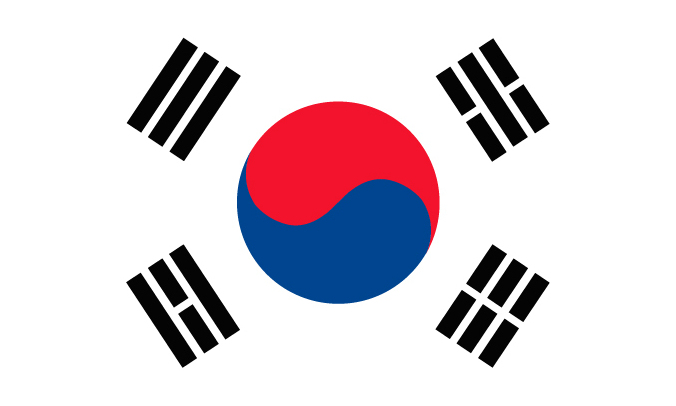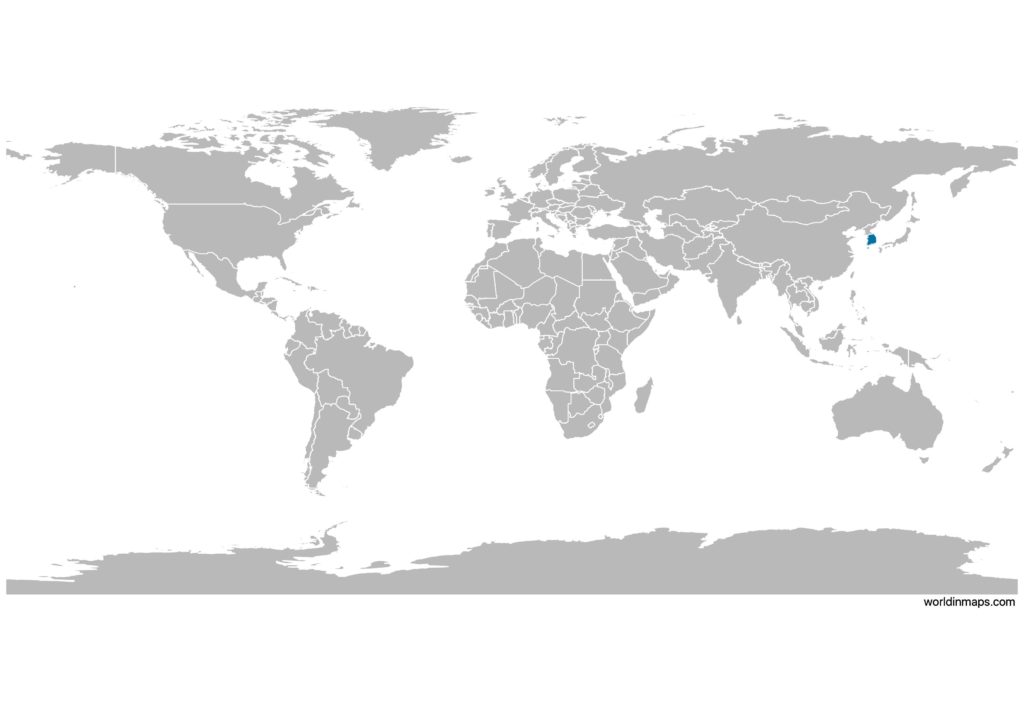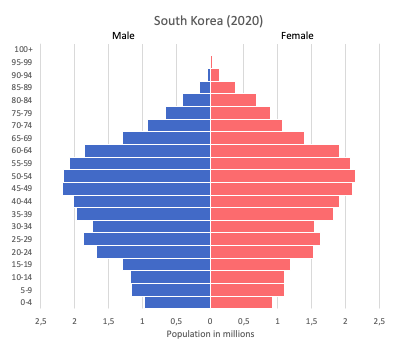South Korea

| Government | |
| Name | Republic of Korea |
| Korean | 대한민국/大韓民國 Daehan Minguk |
| Government type | presidential republic |
| Capital | Seoul (9,904,312 (2015)) |
| Currency | Korean Republic won (KRW) |
| Organization | |
| Observer State | South Asian Association for Regional Cooperation (SAARC) |
| People | |
| Population (2020) | 51,269,183 (27th) |
| Density of population | 507 P/km2 (13th) |
| Nationality | Korean |
| Official languages | |
| Korean | |
| Ethnic groups | |
| Predominantly Korean. No official statistics | |
| Religions (2015) | |
| Protestant | 19.7% |
| Buddhist | 15.5% |
| Catholic | 7.9% |
| none | 56.9% |
| Life expectancy (2020) | |
| Male | 79.4 years |
| Female | 85.9 years |
| Total population | 82.6 years (15th) |
| Homicides | |
| Total (2018) | 0.6 per 100,000 people (155th) |
| Geography | |
| Land area | 96,920 km2 |
| water area | 2,800 km2 |
| total area | 99,720 km2 (110th) |
| Mean elevation | 282 m |
| Lowest point | |
| Sea of Japan | 0 m |
| Highest point | |
| Halla-san | 1,950 m |
| Land use (2011) | |
| Agricultural land | 18.1% |
| Arable land | 15.3% |
| Permanent crops | 2.2% |
| Permanent pasture | 0.6% |
| Forest | 63.9% |
| Other | 18% |
| Urbanization | |
| Urban population (2020) | 81.4% |
| Rate of urbanization | 0.3% annual rate of change (2015 – 2020) |
| Economy | |
| Labor force (2017) | 27.75 million (23rd) |
| Labor force by occupation (2017) | |
| Agriculture | 4.8% |
| Industry | 24.6% |
| Services | 70.6% |
| Unemployment rate (2017) | 3.7% (45th) |
| GDP (PPP) (estimate 2020) | |
| Total | $2.418 trillion (14th) |
| Per capita | $46,451(29th) |
| GDP (nominal) (estimate 2020) | |
| Total | $1.626 trillion (12th) |
| Per capita | $31,246 (27th) |
| GDP by sector (estimate 2017) | |
| Agriculture | 2.2% |
| Industry | 39.3% |
| Services | 58.3% |
| Exports (2017) | $577.4 billion (5th) |
| Exports partners (2017) | |
| China | 25.1% |
| US | 12.2% |
| Vietnam | 8.2% |
| Hong Kong | 6.9% |
| Japan | 4.7% |
| Imports (2017) | $457.5 billion (9th) |
| Imports partners (2017) | |
| China | 20.5% |
| Japan | 11.5% |
| US | 10.5% |
| Germany | 4.2% |
| Saudi Arabia | 4.1% |
South Korea on the world map

South Korea top 10 largest cities (2015)
- Seoul (9,904,312)
- Busan (3,448,737)
- Incheon (2,890,451)
- Daegu (2,446,052)
- Daejeon (1,538,394)
- Gwangju (1,502,881)
- Suwon (1,194,313)
- Ulsan (1,166,615)
- Changwon (1,059,241)
- Goyang (990,073)
Demography
Population pyramid

Age structure data
Estimate for 2020:
- 0-14 years: 12.77% (male 3,401,815/female 3,219,589)
- 15-24 years: 11.18% (male 3,030,027/female 2,764,860)
- 25-54 years: 44.66% (male 12,043,626/female 11,106,927)
- 55-64 years: 15.47% (male 3,927,496/female 4,089,033)
- 65 years and over: 15.92% (male 3,572,855/female 4,678,882)
Remark: the age structure of a population affects a nation’s key socioeconomic issues. Countries with young populations (high percentage under age 15) need to invest more in schools, while countries with older populations (high percentage ages 65 and over) need to invest more in the health sector. The age structure can also be used to help predict potential political issues. For example, the rapid growth of a young adult population unable to find employment can lead to unrest.
Population from 1950 to 2020
Source: United Nations, Department of Economic and Social Affairs, Population Division (2019). World Population Prospects 2019, Online Edition. Rev. 1.
Evolution of the life expectancy from 1960 to 2018
Source: World Development Indicators, The World Bank
Economy
Agriculture:
rice, root crops, barley, vegetables, fruit, cattle, pigs, chickens, milk, eggs, fish
Industries:
electronics, telecommunications, automobile production, chemicals, shipbuilding, steel
Exports – commodities:
semiconductors, petrochemicals, automobile/auto parts, ships, wireless communication equipment, flat displays, steel, electronics, plastics, computers
Imports – commodities:
crude oil/petroleum products, semiconductors, natural gas, coal, steel, computers, wireless communication equipment, automobiles, fine chemicals, textiles
Time zone and current time in South Korea
Go to our interactive map to get the current time in South Korea